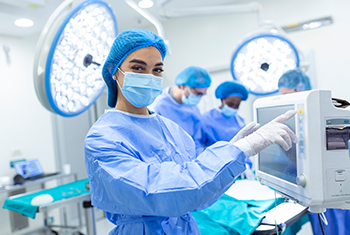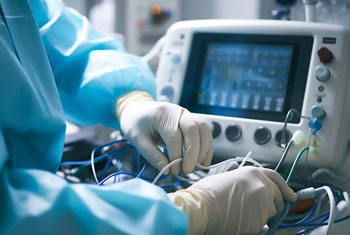Surgeries performed at Venkateshwar Hospital
Brain Surgery: Brain surgery is a complex medical procedure aimed at treating various conditions affecting the brain. Our surgeons carefully navigate the delicate structures of the brain to remove tumors, repair damaged blood vessels, or alleviate pressure caused by swelling. With the induction of the latest technologies and techniques at our Neurosurgery Hospital, Delhi, our team of neurosurgeons are able to perform more precise and minimally invasive surgeries, leading to improved patient outcomes and faster recovery times.
Spine Surgery: Spine surgery involves the diagnosis and treatment of spinal conditions that cause pain or affect mobility. Surgeons use specialized techniques to correct spinal deformities, repair herniated discs, or stabilize the spine after trauma. Minimally invasive approaches, such as endoscopic or robotic-assisted procedures at our hospital, have revolutionized spine surgery by reducing scarring, pain, and recovery time. These advancements enable patients to regain their mobility and quality of life more quickly.
At our specialized neurosurgery hospital, we offer cutting-edge spinal instrumentation, stabilization, and fusion procedures to address a range of spinal conditions, ensuring patients regain mobility and quality of life.
Spinal instrumentation/stabilization/fusion
Spinal instrumentation involves the use of advanced medical devices such as rods, screws, and plates to provide structural support to the spine, promoting proper alignment during the healing process. Our highly skilled neurosurgeons employ minimally invasive techniques whenever suitable, minimizing tissue damage, reducing recovery time, and lowering the risk of complications.
Stabilization procedures aim to prevent excessive movement between vertebrae, which can cause pain and neurological deficits. Through meticulous planning and precise execution, our multidisciplinary team customizes stabilization strategies tailored to each patient's unique needs.
When fusion becomes necessary to address spinal instability or severe degeneration, our hospital excels in both traditional and innovative fusion techniques. By fusing adjacent vertebrae, we eliminate painful motion and allow the spine to heal as a single, solid unit. Our commitment to staying at the forefront of medical advancements ensures access to the latest biomaterials and surgical methods.
At VenkateshwarHospital, patients can expect not only state-of-the-art treatments but also comprehensive pre-operative evaluations, personalized surgical plans, and dedicated post-operative rehabilitation. Our goal is to empower patients with the best possible care, helping them embark on a journey to rediscover pain-free movement and an improved quality of life.
Surgeries performed at Venkateshwar Hospital
Peripheral Nerve Surgery: Peripheral nerve surgery focuses on diagnosing and treating conditions affecting the peripheral nervous system. Surgeons operate on nerves outside the brain and spinal cord to repair injuries, relieve pain, or restore function. Common procedures include nerve decompression to alleviate compression or entrapment, nerve grafting to repair damaged nerves, and neuroma excision to remove painful nerve tissue. Peripheral nerve surgery aims to restore sensation, improve mobility, and enhance
Vascular Brain Surgery: In the field of advanced neurosurgical interventions, vascular brain surgery coiling is widely regarded as a remarkable technique, offering hope to patients with intracranial aneurysms and arteriovenous malformations (AVMs).
Aneurysm coiling is a minimally invasive procedure designed to treat cerebral aneurysms, which are weak points in blood vessel walls that pose a risk of rupture. During the procedure, a neurointerventionist guides a catheter through the blood vessels, reaching the aneurysm site. Subsequently, platinum coils or other bioactive materials are gently inserted into the aneurysm, promoting blood clot formation, and effectively sealing off the aneurysm from the circulation. This innovative technique not only mitigates the risk of rupture but also obviates the need for open surgery, leading to shorter hospital stays and quicker recovery times.
Similarly, AVM embolization represents another landmark development in the field. Arteriovenous malformations are tangled networks of blood vessels that can lead to dangerous bleeding or seizures. In this procedure, a neurointerventionist strategically deposits embolic agents, such as glue-like substances or microspheres, into the AVM, inducing a controlled blockage of blood flow. By gradually closing off abnormal vessels, the risk of hemorrhage or related complications is substantially reduced. This approach can be curative or preparatory, making subsequent surgical removal or radiosurgery safer and more effective.
At our neurosurgery center, these intricate procedures are performed by a team of skilled neurointerventionists using state-of-the-art imaging and navigation technologies. We prioritize patient well-being, providing comprehensive evaluations, personalized treatment plans, and post-procedure care to ensure the best possible outcomes. By embracing advancements like aneurysm coiling and AVM embolization, we strive to enhance patient lives while reaffirming our dedication to pushing the boundaries of neurological care.
Neuro-radiosurgery: Neuro-radiosurgery is a groundbreaking advancement in medical technology that offers precise and non-invasive treatment for various neurological conditions. It involves delivering high doses of radiation to specific targets within the brain, obliterating abnormal tissue while minimizing damage to surrounding healthy structures.
The Versa HD and Linear Accelerator (Linac) are pivotal tools in this field. The Versa HD is a cutting-edge system designed for advanced radiotherapy and radiosurgery. With its exceptional precision, it enables clinicians to precisely shape radiation beams to match the tumor's contour. This enhances treatment effectiveness while minimizing exposure to healthy tissues. Linear Accelerators, commonly used in neuro-radiosurgery, generate high-energy X-rays that can be precisely directed to the target area. These machines rotate around the patient, delivering radiation from multiple angles, ensuring accurate targeting while sparing adjacent tissues. This technology is particularly crucial for treating complex brain tumors and conditions where conventional surgery may have limitations.
Incorporating these technologies into neuro-radiosurgery exemplifies our commitment to pushing the boundaries of medical care, allowing patients to access safer, more effective treatments with minimal disruption to their lives.



